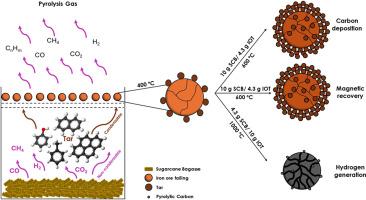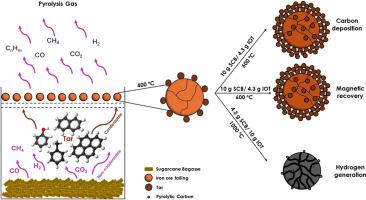甘蔗渣和铁矿石尾矿热化学转化,通过生物碳和氢生产实现可持续铁回收
IF 9.7
1区 环境科学与生态学
Q1 ENGINEERING, ENVIRONMENTAL
引用次数: 0
摘要
从工业废物中回收有价值的化学元素对于生产过程的经济和环境可持续性至关重要。铁矿尾渣和甘蔗渣这两种废物之间的相互作用有可能为未来的炼铁和炼钢工艺提供二次铁源。本研究评估了甘蔗渣(SCB)和铁矿尾渣(IOT)挥发物的使用情况,以协同促进碳沉积、H2 生成以及弱磁性铁氧化物在强磁性铁相中的转化。实验分别在 400、600、800 和 1000 ºC 的温度和不同的 SCB/IOT 比率下进行,并在氮气环境下进行。在所有试验中,SCB 和 IOT 在不同的炉床中同时加热,以防止材料之间直接接触。结合使用 600 ºC 和较高的 SCB/IOT 比率,得到的产品磁铁矿含量为 96.7%,磁性部分回收率为 98%,沉积碳含量为 3.5%。使用较低的 SCB/IOT 比率可提高 H2 产量。无论质量比如何,将 IOT 和 SCB 同时加热至 1000 ºC 都会导致显著的矿物学转变,出现还原相,如黑钨矿、辉绿岩和金属铁,从而影响磁选效率。研究结果表明,使用生物质废料作为钢铁工业的可再生还原剂,可以从 IOT 中回收铁。本文章由计算机程序翻译,如有差异,请以英文原文为准。


Sugarcane bagasse and iron ore tailings thermochemical conversion towards sustainable iron recovery with biogenic carbon and hydrogen production
The recovery of valuable chemical elements from industrial waste is essential for production processes' economic and environmental sustainability. The interaction between the iron ore tailings and sugarcane bagasse, both wastes, has the potential to provide a secondary iron source for future iron and steelmaking processes. This study evaluated the use of volatiles from sugarcane bagasse (SCB) and iron ore tailings (IOT) to the synergistic promotion of carbon deposition, H2 production and conversion of weak magnetic iron oxides in strong magnetic iron phases. The experiments were carried out at 400, 600, 800, and 1000 °C with different SCB/IOT ratios under an N2 atmosphere. In all tests, SCB and IOT were heated simultaneously in separate beds to prevent direct contact between the materials. The combination of 600 °C and higher SCB/IOT ratio resulted in a product with 96.7% magnetite, 98% magnetic fraction recovery, and 3.5% deposited carbon. The use of lower SCB/IOT ratio provided an increase in H2 production. Regardless of the mass ratio, heating the IOT and SCB simultaneously up to 1000 °C led to significant mineralogical transformations, reaching reduced phases such as wüstite, fayalite and metallic iron, which impaired magnetic separation efficiency. The results indicate an alternative for recovering iron from IOT using biomass waste as a renewable reducing agent for the steel industry.
求助全文
通过发布文献求助,成功后即可免费获取论文全文。
去求助
来源期刊

Journal of Cleaner Production
环境科学-工程:环境
CiteScore
20.40
自引率
9.00%
发文量
4720
审稿时长
111 days
期刊介绍:
The Journal of Cleaner Production is an international, transdisciplinary journal that addresses and discusses theoretical and practical Cleaner Production, Environmental, and Sustainability issues. It aims to help societies become more sustainable by focusing on the concept of 'Cleaner Production', which aims at preventing waste production and increasing efficiencies in energy, water, resources, and human capital use. The journal serves as a platform for corporations, governments, education institutions, regions, and societies to engage in discussions and research related to Cleaner Production, environmental, and sustainability practices.
 求助内容:
求助内容: 应助结果提醒方式:
应助结果提醒方式:


